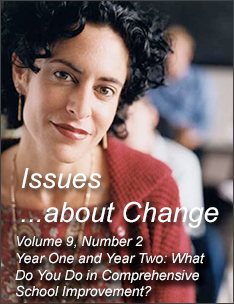Organizational Structures
Year 1.
During Year 1, SEDL staff familiarized themselves with the organizational structures that existed at partner schools, and assisted in the development of organizational structures where there were none. The reconstitution of Banner High School into academies required that new communication structures be developed and implemented. Pelican High School, which had recently been created by the division of a K-12 school into an elementary, middle, and high school, had a similar need to develop new organizational structures, particularly addressing communication between central office staff and the school.
At Community High and San Fernando School, organizational structures that were already in place were strengthened and supported through the FIRST partnership. At Community High, the principal provided meals and, in some cases, stipends, in support of after-school planning meetings among teachers; this was to change in year two. Facilitation of meetings at San Fernando School helped to assure that all staff were included in planning, and all voices were heard at staff meetings. At San Fernando, SEDL also assisted in the creation and operation of action research teams, which collected and presented the data utilized in developing that schools focus of improvement work.
Organizational structures at Tall Pines provided little support for change. Systems for routine procedures, such as tracking attendance and communicating hallway duties, were lacking. Communication among teachers and between the school administration and teachers was sporadic and ineffective. Structures such as grade level teams and the school's steering committee, while in place, were not utilized effectively. Grade level teams collaborated on student discipline, parent/teacher conferences, and planning for special events. The school's steering committee existed primarily to communicate the principal's unilaterally developed agenda to the rest of the staff. Expectations and opportunities for teacher leadership or problem-solving were nearly non-existent.
Year 2.
During the FIRST initiative's second year, organizational structures remained a focus of attention at partner schools. SEDL facilitators sought to enhance structures and practices that worked and mitigate the effects of structures that did not exist or work well. When funds to provide meals and stipends for professional development dried up at Community High School, SEDL supported the principal in utilizing other school resources to support improvement efforts. Communication via e-mail helped fill the gap created by fewer meetings; the school's video equipment (and students) provided a means to create videotapes of training activities.
At Pelican High School, in light of a new school structure, and with the cooperation of a new administrator, SEDL staff supported school personnel in adapting necessary procedures to the new organization and structures. At Banner High School, FIRST efforts targeted one academy of the four (that understood the value of FIRST and articulated interest) created by the division of a large high school.
The lack of organizational structure at Tall Pines Middle School remained a significant obstacle to school improvement efforts. The SEDL facilitator at Tall Pines advocated for fuller use of existing organizational structures, and helped the principal realize the strength and skills of the campus leadership team. In addition, the facilitator created opportunities from external mandated policies; the district required the completion of a campus plan - a difficult task given the lack of organization and staff expertise that characterized Tall Pines. The SEDL coordinator volunteered to assist in this effort, and in the process modeled inclusion, data driven decisions, planning, and communication - and embedded greater capacity for ongoing school improvement into Tall Pine's future.
District requirements provided accountability and legitimacy to school efforts at San Fernando School. Here, the SEDL facilitator utilized district pressure to align curriculum within the school, and with state assessments helped to unify teachers - by quelling resistance - in taking the "next steps" in the school's focus on improved mathematics instruction and achievement.
Reflection.
As a result of two years' work in partner schools, SEDL staff learned that they had been too optimistic in terms of organizational structures at partner schools. Partner schools functioned with minimal organization, allowing informal networks and unspoken expectations to guide and define their work, and reinforcing the isolation of teachers in their individual classrooms. Without clear access to information, the means to express opinions, or the assurance that their perspective would be honored, teachers and staff retreated from one another, convinced themselves that school-wide improvement was impossible, and focused their efforts narrowly.
SEDL facilitators found themselves working within organizational structures that were cumbersome and ineffective, or creating new organizational structures with personnel who were often skeptical and occasionally resistant. Facilitators found this work to be critical to maintaining improvement efforts, but also to be quite difficult, thankless, and slow to show benefits.
Next Page: Personal and Social Dynamics of Individuals and Organizations

